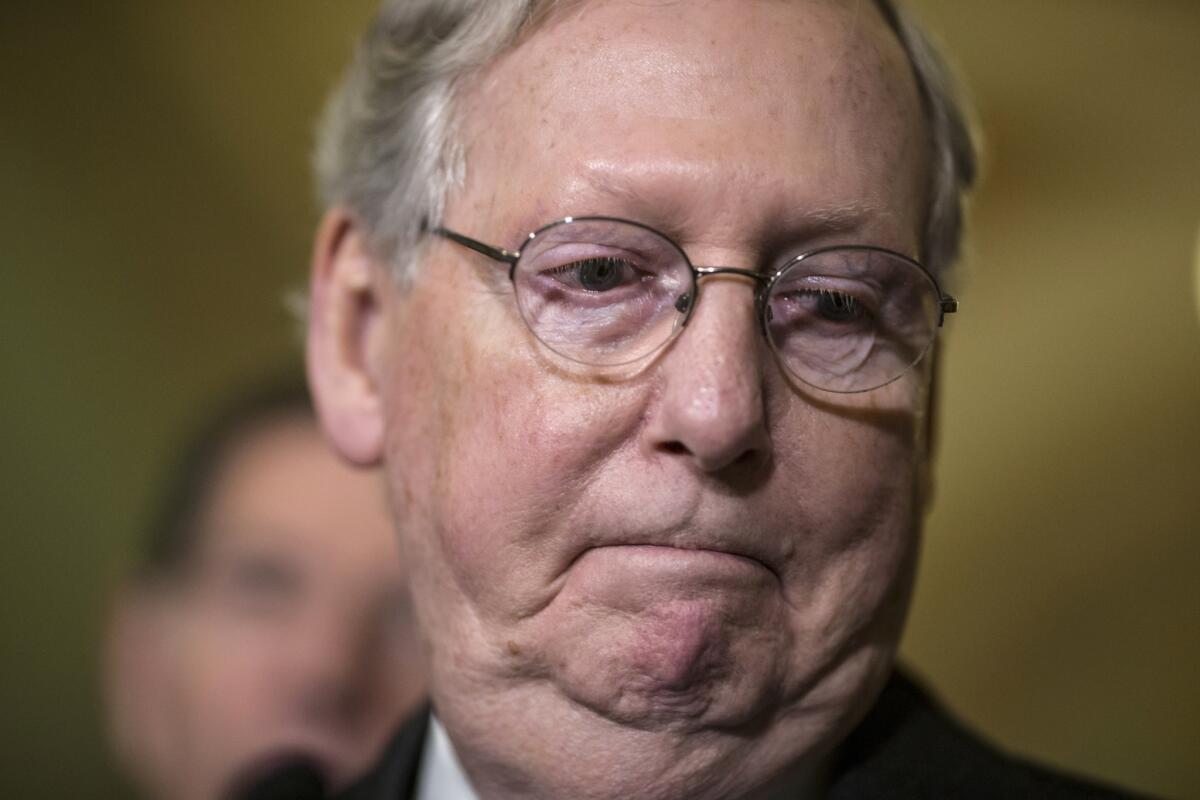Op-Ed: Democrats have a secret weapon to thwart a rapid Ginsburg replacement. They should use it

- Share via
Wouldn’t it be nice if Democrats and Republicans could just agree that the fair and right course would be to not replace Justice Ruth Bader Ginsburg until after the presidential inauguration in January? We could simply stick, for now, with the precedent established by Senate Majority Leader Mitch McConnell when he refused to hold a vote on the nomination of Merrick Garland to replace Justice Antonin Scalia.
At the time, nearly nine months before the 2016 presidential election, he declared, “The American people should have a voice in the selection of their next Supreme Court justice. Therefore, this vacancy should not be filled until we have a new president.”
For the record:
8:14 a.m. Sept. 19, 2020In a previous version of this article, Judge Amy Coney Barrett’s last name was misspelled as Barret.
But just hours after the announcement of Ginsburg’s death on Friday, McConnell declared, “President Trump’s nominee will receive a vote on the floor of the United States Senate.”
There is little Democrats can do to stop Trump from nominating someone and the Republicans from confirming that person quickly, if that’s what they choose to do. Republicans hold a 53-47 majority in the Senate, and they have eliminated the use of the filibuster in Supreme Court nominations. So the hope must be that four Republican senators — perhaps those facing tight reelection races — will have the courage to stand up to their party and refuse to allow a confirmation to be rushed through.
That is probably a distant hope. So far, Senate Republicans have shown little inclination to stand up to Trump and McConnell, as was evident in their confirming Brett Kavanaugh for the Supreme Court, despite compelling testimony about an alleged sexual assault and perjury — and despite clear evidence that he lacked judicial temperament. Nor did Republicans demonstrate any independence or courage during the impeachment of Trump.
That leaves Democrats with few cards to play at a crucial moment for our democracy. The stakes are enormous. Last term, with Ginsburg on the bench, the court handed down surprising 5-4 decisions to protect individual rights, including a decision to strike down Louisiana’s restrictive abortion law and to invalidate Trump’s rescission of the Deferred Action for Childhood Arrivals program. If Ginsburg is replaced by a hard-line conservative who puts politics and feelings ahead of the law, the chance of such rulings will evaporate.
On the current court, Chief Justice John G. Roberts Jr. is ideologically in the middle. To be sure, he is to the right of America’s current political center, but at times he joins with the liberals, including in a vote to uphold the Affordable Care Act. If Ginsburg is replaced with someone from the far right, like Judge Amy Coney Barrett, who is frequently mentioned as a likely nominee, there will be five justices substantially more conservative than Roberts. There would be virtually no hope that abortion rights could survive such a court, and little chance of checking Trump.
One way for Democrats to make clear they will not tolerate Republicans trying to fill this seat in advance of the election would be for them to pledge that, if they take the White House and Senate in November, they will increase the size of the Supreme Court to 13 justices.
The number of justices on the court is set by federal law, not the Constitution. Since its beginnings, it has ranged from having between five and 10 members. Since the 1860s, it has remained at nine.
When President Franklin Roosevelt suggested expanding the Supreme Court in the 1930s to overcome court hostility to the New Deal, he was repudiated for trying to pack the court. But the current situation is different. This would be a response to chicanery by Republicans.
What happened with Garland’s nomination was unprecedented, and Democrats rightly believe it was a stolen seat. After Scalia’s death in February 2016, President Obama moved quickly, nominating Garland the next month.
Prior to that time, there had been 24 Supreme Court vacancies in presidential election years. In 21 instances, the Senate confirmed the nominee and in three instances it did not. But never before had the Senate refused to hold hearings and vote. If Republicans now rapidly confirm a replacement for Ginsburg, an antidote from the Democrats will be necessary.
The threat of increasing the size of the court to 13 might be enough to discourage Republicans from their dirty tricks. But if they do it anyway, and the November election produces a Democratic win in the White House and a Democratic majority in the Senate, Congress would be totally justified in increasing the size of the court.
It shouldn’t have to come to this. Republicans should be trying to bridge differences rather than inflaming the situation. It is sad that just hours after Ginsburg’s death the focus is on the political machinations rather than her legacy.
No other justice in history has become a popular icon in the way she did. She modeled for all of us in how to spend a life working to make society and individual lives better. We only can hope for a new justice in her mold.
Erwin Chemerinsky is dean of the UC Berkeley School of Law and a contributing writer to Opinion.
More to Read
A cure for the common opinion
Get thought-provoking perspectives with our weekly newsletter.
You may occasionally receive promotional content from the Los Angeles Times.










